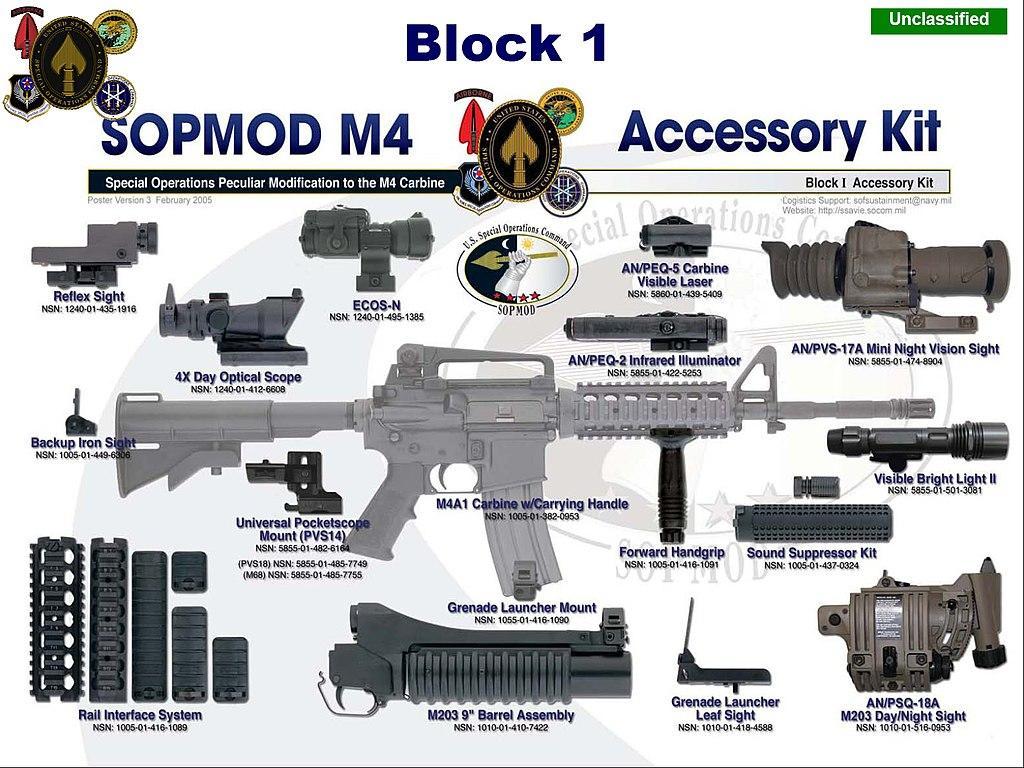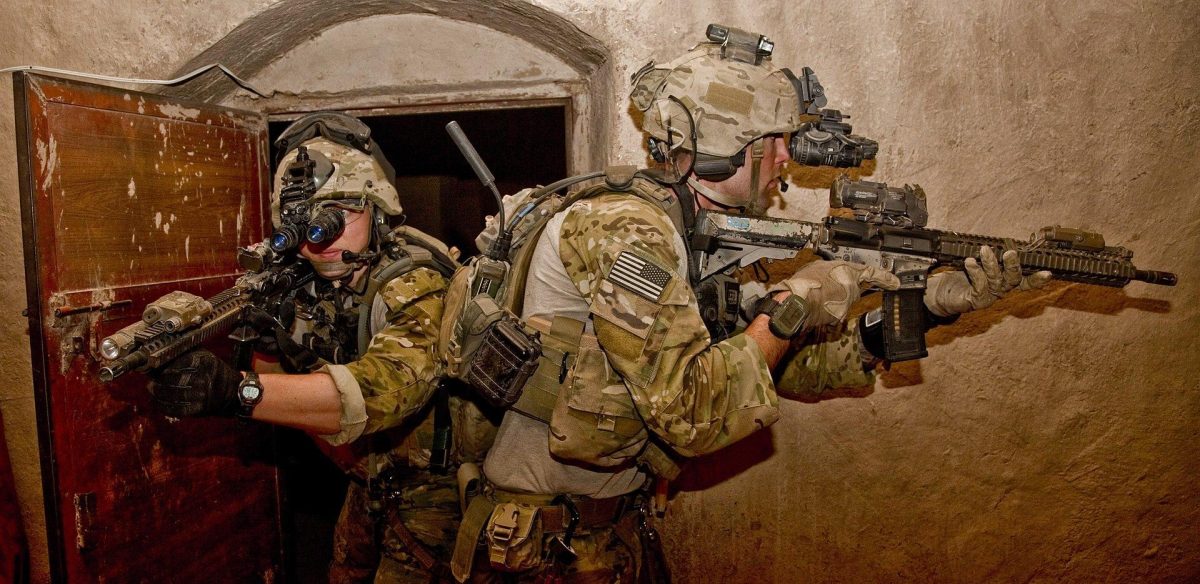The M4 Carbine is one of the most popular rifles and the first pick for many special operations forces operators. It belongs to a family of firearms tracing its lineage back to earlier carbine versions of the M16, all based on the original AR-15 designed by Eugene Stoner and made by ArmaLite. It has been in service for more than 25 years.
Rugged, simple, and accurate, the M4 Carbine is the standard infantry weapon of not just the Army but all of America’s ground forces.
Introduction
The M4 Carbine is a shorter and lighter version of the Colt M16A2 assault rifle, with 80% of parts commonality. The rifle has selective fire options, including semi-automatic and three-round bursts (like the M16A2), while the M4A1 has a “full auto” option along with a three-round burst.

History
The story of the M4 Carbine goes back to the mid-sixties and the early days of the Vietnam War. The Pentagon, mulling sending hundreds of thousands of troops to South Vietnam, wanted a small, lightweight service rifle to replace the larger standard-issue M14. The new AR-15, or Armalite Rifle-15, was smaller, lighter, and fired a smaller 5.56-millimeter bullet. A soldier carrying the AR-15, later designed as the M16, could carry twice as much ammunition as a soldier carrying the M14. Demographic trends also meant that more and more soldiers were coming from cities and unfamiliar with firearms, and the M16, with less recoil, was easier to train soldiers to become proficient.
The M16 quickly started racking up complaints despite earlier battlefield success once fielded in large numbers. A last-minute change in propellant powder and the erroneous belief that the rifle never needed cleaning caused many jams on the battlefield. Although the problems were eventually sorted out and an improved version, the M16A1, was fielded in 1967, the weapon developed a reputation as an unreliable weapon. In the mid-1980s, the A1 was replaced with the M16A2, which featured a thicker barrel and three-round burst capability.
In the early 1990s, the Army purchased a limited number of M4 carbines. The M4 Carbine had a collapsible stock and a shorter, 14.5-inch barrel instead of the longer twenty-inch barrel of the M16A2. That made the weapon easier to carry in tight spaces, particularly in armored vehicles and helicopters, while also easier to operate on close-quarter battlefields such as cities or jungles. The price for shortening the barrel slightly decreased muzzle velocity and range, but these were considered acceptable tradeoffs.
Design
The M4 Carbine and its variants are chambered in 5.56×45 mm NATO ammunition (or .223 Remington ammunition). The M4 is a gas-operated, air-cooled, magazine-fed, selective fire rifle with a multi-position telescoping stock. The first versions of the carbine had a flat-ended telescoping stock, but newer models are now equipped with a redesigned telescoping stock that is slightly larger with curvature at the end.
The M4 Carbine is similar to earlier M16 versions, such as the 1960s-era XM177 family. Some of those visual designs are obvious in both weapons. However, most of the similarities are not very noticeable. The main advantage of the M4 is its operability because it is handier and more convenient than a full-length assault rifle. It doesn’t affect the rifle’s ballistic performance compared to the full-size M16 (6″ longer barrel). This becomes most apparent at ranges of 300 yards and beyond.

But if we look from a statistical point of view, the most small-arm engagements occur within 100 yards. The M4 Carbine is a good weapon for most troops, especially modern special operations forces, and their usage in counter-terrorism missions. In exchange for greatly improved handling characteristics, the marginal sacrifice in terminal ballistics and range is usually considered a worthwhile compromise.
CQB and CQC
While the M4 Carbine′s maneuverability makes it a candidate for non-infantry troops (vehicle crews, clerks, and staff officers), it also makes it ideal for close-quarters battle (CQB) and close-quarters combat (CQC). The M4 was developed and produced for the United States government by Colt Firearms, which had an exclusive contract to build the M4 family of weapons through 2009. However, several other manufacturers offer M4-like firearms.
The M4A1 and the M16A4 have mostly replaced the Colt M16A2; the U.S. Air Force, for example, plans to transition completely to the M4 Carbine. The M4 is also the standard rifle for U.S. Air Force Security Forces members, whether at home or deployed abroad. They maintain a yearly qualification on it.
The United States Marine Corps has ordered its officers (up to the lieutenant colonel) and Staff Non-commissioned officers to carry the M4A1 carbine instead of the M9 handgun. This is in keeping with the Marine Corps motto, “Every Marine is a rifleman.” United States Navy corpsmen will also be issued M4A1s instead of the M9.
Wars in Iraq and Afghanistan
The wars in Iraq and Afghanistan accelerated the adoption of the M4 Carbine to the point where it is carried by the majority of the U.S. Army and Marine Corps. The weapon weighs 7.3 pounds and is loaded with a thirty-round magazine. Infantry and other combat arms typically carry an M4 with a series of authorized add-ons, including Aimpoint red dot sights, Trijicon ACOG fixed-power rifle scopes, foregrips, laser designators, and the M320 under-barrel grenade launcher. This can easily push the weapon’s weight up to nine pounds. While heavier, this is still short of the World War II-era M1 Garand rifle, which weighed 11.2 pounds.

The M4 Carbine still has its critics, including a retired major general, who have derided this descendant of the M16 as inadequate for modern ground forces. They point to the direct impingement gas operating system, which siphons off hot gases from burning gunpowder to chamber the next round, as guilty of fouling the inside of the rifle, increasing the likelihood of jams. They also deride the 5.56-millimeter round as having insufficient stopping power and believe the M4’s barrel is not thick enough to avoid overheating in sustained fire.
Variants
The M4 Carbine doesn’t have so many variants especially designed, because it is considered the most modular and accessible weapon platform in the world. Here is the list of considerable variants:
- M4A1
- XM177E2
- M4 MWS (Modular Weapon System)
- Mk 18 CQBR
- Enhanced M4
- M4 Commando
- Armwest LLC M4
M4A1
The M4A1 carbine is a fully-automatic variant of the basic M4 carbine intended for special operations. The main difference between the M4A1 and “regular” Mr is in fire modes. The M4A1 has an “S-1-3-F” (safe/semi-automatic/3-round burst/fully automatic) trigger group, while the M4 has an “S-1-3″ (safe/semi-automatic/3-round burst) trigger group.
Today, the M4A1 is issued to almost all U.S special operation units. The M4A1 is especially favored by counter-terrorist and special forces units for close-quarters combat (CQC) because of the carbine’s compactness and firepower. To clarify, carbines have shorter barrels than assault rifles; this means they do worse at the range but are easier to use in small rooms and urban warfare.
The M4A1 has an effective range of 150 meters (160 yds) or less and has a maximum effective range of about 500 to 600 meters (550–660 yd).
Accessories
All that being said, the troops believe the M4 works. A 2006 CNA Corporation report surveyed U.S. Army combat veterans of Iraq and Afghanistan for their opinions on modern infantry weapons. Eighty-nine percent felt their M4 carbine was reliable in combat, and only 19 percent had experienced a stoppage in battle. Eighty percent expressed confidence in their weapon. While these numbers might be good for a garrison army, keep in mind this is from troops that used their weapons in combat in some of the roughest, unforgiving environments on Earth.
In the meantime, the Army is working to correct the M4’s deficiencies. Earlier bullets were designed to penetrate Soviet body armor and sacrificed lethality for armor penetration. The new M855A1 Enhanced Performance Round, aside from being lead-free and “green,” yaws more quickly when passing through the human body, creating an internal cavity and causing massive damage. The M855A1 is also more adept at penetrating steel plates.
The Army is also upgrading its existing M4s to a new M4A1 standard. The upgrade consists of a new fire control group that replaces three-round burst fire mode with fully automatic, an improved trigger and a heavier barrel for longer, more sustained fire before overheating. The A1 also has ambidextrous controls for lefties. New rifles are being delivered to the M4A1 standard, and older rifles are being converted at approximately three hundred a day.
SOPMOD Block I
USSOCOM developed the Special Operations Peculiar Modification (SOPMOD) Block I kit for units’ carbines under its jurisdiction. It brings the M4 Carbine to a whole new level. The SOPMOD Block I kit includes:
- M4A1 rifle
- Rail Interface System (RIS) handguard developed by Knight’s Armament Company
- shortened quick-detachable M203 grenade launcher
- leaf sight
- KAC sound suppressor
- KAC back-up rear sight
- Insight Technologies AN/PEQ-2A visible laser/infrared designator
- Trijicon’s ACOG and Reflex sights
- night vision sight
This kit was designed to be configurable (modular) for various missions, and the kit is currently in service with special operations units.

SOPMOD Block II
A second-generation SOPMOD kit (now known as SOPMOD II) had many different manufacturers competing for the contract. The new SOPMOD Block II includes innovative optics, such as the Elcan Specter DR, Trijicon’s ACOG TA01 ECOS model, and the EOTech 553. Block II uses the RIS II rails manufactured by Daniel Defense in both 9.5 and 12.5-inch lengths.
Notable bidders include Knight’s Armament Company, Atlantic Research Marketing Systems (ARMS), and Lewis Machine & Tools. Daniel Defense has won the contract for the RIS-II, the next generation of rail handguards.

Difference between M4A1 vs. M4 Carbine
There are slight differences between these two rifles, but it is only a minor improvement. Here is the list of the major improvements and differences between the M4A1 and M4 rifles:
- M4A1 has Full auto that replaces the M4’s 3-round burst
- M4A1 has an ambidextrous safety
- M4A1 has a heavier barrel than the M4
- M4A1 is the Army’s new standard carbine issued to all units, infantry and combat arms taking precedents
No rifle is ideal for the U.S. Armed Forces, which must expect to fight in all environments and climates. A heavier, harder-hitting round would reduce the number of ammunition soldiers could carry and place additional burdens on the logistical system. A longer rifle barrel imparts greater range and velocity but makes a weapon unwieldy indoors. Design tradeoffs and compromises are inevitable and must be made with existing and future battlefields in mind. The M4 is a perfect compromise weapon.
Technical specifications: M4 Carbine
| Country of origin: | United States |
| Manufacturer: | Colt’s Manufacturing Company LLC |
| Designed: | 1982 |
| Service: | 1994-present |
| Type: | gas-operated, selective fire, rotating bolt, carbine |
| Caliber: | 5.56 mm (.223 in) |
| Barrel: | 14.5 in (368 mm) |
| Weight (empty): | 6.63 lbs (3.01 kg) |
| Effective firing range: | 500 m |
| Rate of fire: | 700–950 rounds per min |
| Magazine capacity: | 30-round box magazine or other STANAG magazines. Magazines with different capacities are also available. |
